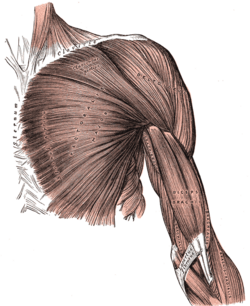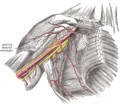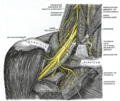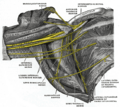Pectoralis major facts for kids
The pectoralis major is a large, fan-shaped muscle in your chest. It's often called the "pecs" or "chest muscle." This muscle is very important for moving your arm and shoulder. It sits right under your breast tissue. Below it is a smaller muscle called the pectoralis minor.
The pectoralis major starts from your collarbone (clavicle), breastbone (sternum), and the cartilage of your ribs. It also connects to a strong sheet of tissue from your stomach muscles. From there, it stretches across your chest and attaches to the upper part of your arm bone (humerus).
This muscle helps you do many things, like:
- Bending your arm forward (flexion), like when you throw a ball underhand.
- Bringing your arm closer to your body (adduction), like when you flap your arms.
- Turning your arm inward (internal rotation), like in an arm wrestle.
Quick facts for kids Pectoralis major |
|
|---|---|
 |
|
| Superficial muscles of the chest and front of the arm | |
| Latin | Musculus pectoralis major |
| Artery | pectoral branch of the thoracoacromial trunk |
| Nerve | lateral pectoral nerve and medial pectoral nerve Clavicular head: C5 and C6 Sternocostal head: C7, C8 and T1 |
Contents
How the Pectoralis Major Is Built
Where the Muscle Starts
The pectoralis major muscle begins in a few places. It starts on the front surface of the inner half of your clavicle (collarbone). It also starts from the front of your sternum (breastbone), going down to about your sixth or seventh rib. Additionally, it connects to the cartilage of most of your true ribs and a strong sheet of tissue from your abdominal external oblique muscle (a stomach muscle).
Where the Muscle Attaches
From these starting points, the muscle fibers come together. They form a flat, strong cord called a tendon, which is about 5 centimeters wide. This tendon attaches to the outer edge of a groove on your humerus (upper arm bone).
This tendon has two main layers, one in front of the other, which usually blend together.
- The front layer is thicker. It receives fibers from your collarbone and the upper part of your breastbone.
- The back layer receives most of the fibers from the breastbone and the deeper fibers from the costal cartilages (rib cartilages). These deeper fibers twist around as they attach higher up on the humerus.
How Nerves Control the Muscle
The pectoralis major muscle gets signals from two main nerves: the medial pectoral nerve and the lateral pectoral nerve. These nerves tell the muscle when to move. The part of the muscle connected to your collarbone is controlled by nerves from your C5 and C6 spinal levels. The part connected to your breastbone is controlled by nerves from your C7, C8, and T1 spinal levels.
These nerves also send information back to your brain. This information helps your brain know how your muscle is moving and where your arm is in space.
Different Muscle Shapes
Sometimes, the pectoralis major muscle can look a little different from person to person. For example, the part that attaches to the ribs or breastbone might be larger or smaller. The two main parts (collarbone and breastbone sections) might be more or less separated. In some rare cases, the entire muscle might be missing, usually on one side of the body. This condition is called Poland syndrome.
What the Pectoralis Major Does
The pectoralis major muscle is key for several movements of your shoulder joint.
- It helps you flex your arm, which means bringing it forward and up. Think of throwing a ball underhand.
- It helps you adduct your arm, which means bringing it closer to your body. Imagine flapping your arms down.
- It helps you medially rotate your arm, which means turning it inward. This happens when you arm-wrestle.
- It also helps keep your arm connected to your body.
The muscle has two main parts that work together but also have slightly different jobs.
- The clavicular part (near your collarbone) helps with flexing, bringing your arm across your body, and turning it inward.
- The sternocostal part (near your breastbone) helps bring your arm down and forward, and also turns it inward, especially when you bring your arm close to your body. This part can also help extend your arm, but not past its normal resting position.
To make the pectoralis major stronger and bigger, you need to do exercises that involve pushing motions. Exercises like the barbell bench press, dumbbell bench press, and machine bench press are great for activating this muscle. Using heavier weights can also help activate the muscle more.
Important Medical Information
Injuries to the Pectoralis Major
Tears in the pectoralis major muscle are not very common. When they do happen, they usually affect athletes, especially those in sports like powerlifting. These injuries can cause pain, weakness, and make it hard to use your arm. Most tears happen where the muscle connects to its tendon. They often occur from a sudden, strong contraction, like when lifting heavy weights during a bench press.
If the tear is severe, doctors usually recommend surgery to fix it. This is especially true for athletes who want to regain full strength. After surgery, the arm is kept still in a sling for about six to eight weeks. Then, physical therapy helps the person regain movement and strength over several months. Most people can return to their activities after six months to a year, often with good results. Doctors use imaging tests like ultrasound and MRI to see the tear and plan treatment.

Poland Syndrome
Poland syndrome is a rare condition that someone is born with. In this syndrome, the pectoralis major muscle is missing on one side of the body. Other signs can include shorter or webbed fingers on the same side. Even though missing this muscle is not life-threatening, it can make certain arm movements harder. For example, bringing the arm close to the body or turning it inward might be difficult. Other muscles, like the latissimus dorsi, can sometimes help make up for the missing pectoralis major.
In 1990, doctors in Seoul, Korea, reported a case of a 22-year-old marine who was born without his right pectoralis major. He had no problems with daily activities, but found some military training, like throwing a grenade or rope climbing, difficult. Even without the muscle, his shoulder strength was good for many movements, showing that other muscles were helping him.
Other Muscle Issues
Very rarely, the pectoralis major muscle can develop harmless growths called lipomas. These are fatty tumors that can sometimes look like breast enlargements. Doctors can use computed tomography (CT) scans and magnetic resonance imaging (MRI) to identify them. If these tumors are large, doctors usually remove them completely to prevent any future problems.
Images for kids
See also
 In Spanish: Músculo pectoral mayor para niños
In Spanish: Músculo pectoral mayor para niños
- Pectoralis minor, a smaller muscle located under the pectoralis major.
- Sternalis, an extra muscle found in some people, which might be related to the pectoralis major.
- Tra Telligman, a retired American mixed martial artist who was born with only one pectoral muscle.














